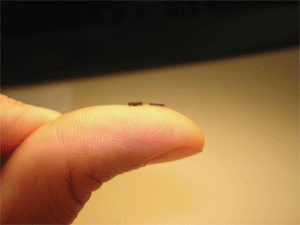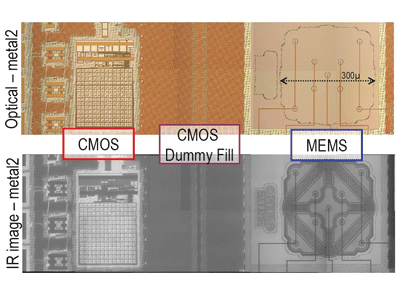Here is what you need to know about these devices and more
BY JOHN McDONALD
SiTime, Sunnyvale, CA
http://www.sitime.com
MEMS oscillators, resonators, and clock products are a new, fast-growing timing market segment. These products are replacing traditional quartz and clock chips by combining both functions into a single IC. In addition, MEMS products are smaller than quartz devices at similar prices, offer great reliability, and are extremely tough with the highest performance ratings for shock and vibration. The list of new capabilities continues to grow with each month. For example, MEMS oscillators now claim the title to the world’s smallest high-Q oscillators, world’s toughest high-Q oscillators, and world’s smallest programmable oscillatorsall at competitive prices.

Time is money
There has been much speculation in the technical press about the cost competitiveness of a MEMS timing solution. However, this issue can be laid to rest as the parts are available in volume at competitive prices.
The MEMS manufacturing advantages are numerous: 200-mm CMOS wafer fabrication for reduced lot-to-lot variation, standard IC packaging for reliability and cost, and electrical programming of the clock output frequency for fast delivery resulting in a low-cost solution, that is available in high volumes with short lead times. The days of worrying about the lack of availability of quartz are over.
And that list of MEMS timing accomplishments is just for starters. As recently as September, engineering samples are available for the world’s lowest-jitter and smallest programmable oscillators, as low as 0.5-ps phase jitter (random) for Gigabit Ethernet, Fibre Channel, and SATA/SAS standards. This new level of performance is taking MEMS programmable oscillators into new market areas that were previously the domain of very expensive quartz devices. Going forward, this high-performance trend will continue as both the MEMS resonators and PLLs improve in phase noise.
New ultrathin 0.4-mm oscillators were also announced in September setting the world record for the thinnest high-performance programmable oscillators. This capability is made possible because the MEMS resonator is only a 0.15-mm-thick die. These oscillators and resonators provide a solution for robust high-performance clock sources in ultrathin applications. Imagine high-performance clocks inside of smart cards, high-density memory modules, and tiny wireless nodes. The brittleness of quartz prohibit many thin-product ideas from ever reaching the market, and reduces the yield of those that do, while increasing the cost
Q matters
Let’s examine in greater detail why this timing industry transformation is occurring and why MEMS oscillators make so much sense. Many technologies have promised to replace commercial grade quartz, but all these competitive technologies have failed to achieve that goal for over 40 years. An analysis of why nonquartz timing technologies have failed reveals that most cannot meet the inherent stability of quartz, and in the few cases where excellent stability is achieved it is accomplished at a cost that is orders of magnitude higher than the existing quartz solution.
Q, or quality factor, is a measure of how well a resonator retains its energy. For a real world example, a bell has high Q, such that after it is struck the sound can be heard for quite some time, while a plastic cup has low Q, such that after the cup is struck the audio energy almost instantly dissipates.
Quartz manufacturers offer devices in the ±5 to ±100-ppm range with the most common ppm specifications between ±50 and ±100 ppm. Quartz manufacturers can achieve this very good stability because quartz resonators have a very high Q of between 50,000 to 250,000. The Q of quartz can reach to 1 million to 3 million for extreme scientific applications. MEMS resonators also have excellent Q. SiTime’s products, technical papers from Discera Corp., and many academic papers prove that MEMS resonators are being manufactured at approximately 80,000 and are capable of Q factors greater than 500,000.
Q matters because it is proportional to stability. Q is defined by the center frequency of the resonator divided by the bandwidth at the 3-dB level. A resonator of a low Q value of 100 has a wide Q curve of approximately 10,000-ppm variation. Therefore every slight variation in packaging stress and process affects the resonate frequency.
Frequency stability or frequency ppm error is practically limited to one half the frequency bandwidth measured at 3 dB from the resonate peak. Even with careful initial calibration, a sub-1,000 Q resonator is very susceptible to aging error in 10’s to 100’s of ppm per year. In contrast, MEMS resonators achieve Q’s from 50,000±1% to 200,000±1% determined by design. A Q of 100,000 yields a approximately 10-ppm variation, which yields lot-to-lot manufacturability levels of 5 ppm or better and are virtually ageless.
Not all silicon oscillators are alike
MEMS oscillators are made out of pure single crystal silicon and use a mechanical beam that vibrates. MEMS oscillators should not be confused with silicon oscillators that are based on low-Q LC tank electronic circuits. Most LC tank circuit silicon oscillators have low Qs and poor stability. Most of these products offer some level of programmability and are good for clocking microprocessors and applications where ppm is of little importance.
The future of MEMS
Going forward, MEMS will be integrated directly with CMOS (see Fig. 1). Integration will yield many benefits in continuous size reduction, better performance, and less manufacturing complexity. The overwhelming size advantage of MEMS solutions will provide an avenue for further size reductions in wireless nodes, multichip modules, and lead to the elimination of quartz from the PCB altogether. SiTime’s EpiSEAL and MEMS First process is an example of what is possible with CMOS integration.

Fig. 1. Going forward, MEMS will be integrated directly with CMOS.
Recent developments allowed successful integration of advanced 0.18-μm CMOS circuitry with fully functional MEMS. The CMOS statistical process control parameters showed no change between the CMOS circuitry with the MEMS resonator and without the MEMS resonator on the same die. Likewise, the MEMS showed no change in key manufacturing performance metrics with CMOS or without CMOS. ■
For more on MEMS oscillators, visit http://electronicproducts-com-develop.go-vip.net/passives.asp.
Advertisement
Learn more about SiTime





